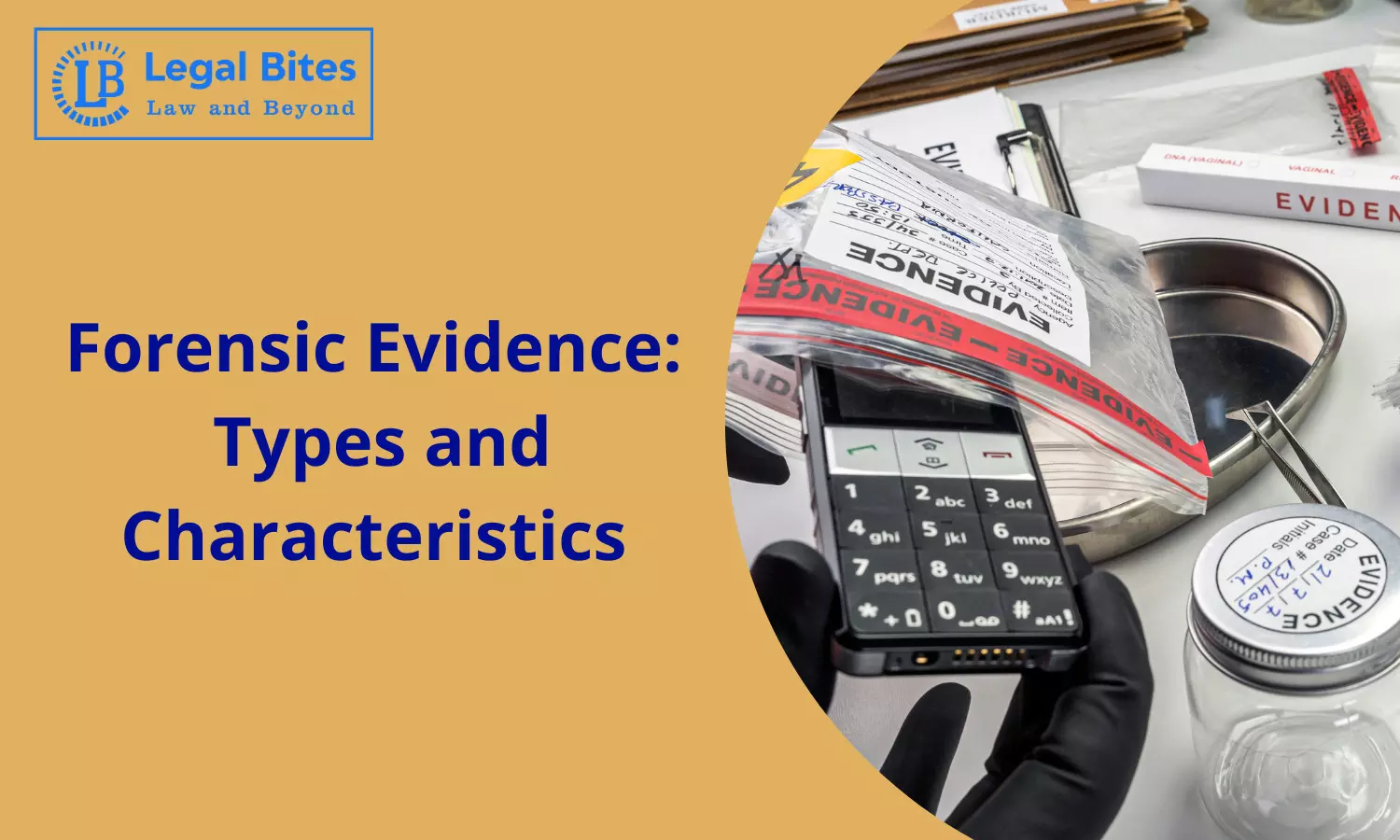Forensic Evidence: Types and Characteristics
This article aims to provide a comprehensive overview of the pivotal role forensic evidence plays in criminal investigations

This article 'Forensic Evidence: Types and Characteristics' aims to provide a comprehensive overview of the pivotal role forensic evidence plays in criminal investigations and its fundamental attributes that contribute to the pursuit of justice.
Forensic evidence is important for the purpose of investigation of certain criminal offences such as murder, homicide, rape and other sexual offences. This is often useful in eliminating and narrowing down the possible suspects in situations where there are no eyewitnesses and the offence that is being investigated for is grave in nature involving imprisonment for life or the death penalty.
Thus, it assists in proving the guilt of the accused beyond reasonable doubt. Thus, forensic evidence is one of the most reliable sources of evidence useful in today’s justice dispensation system. The practice of collecting and recording forensic evidence is also referred to as forensic science. This thereby involves the scientific collection and analysis of physical evidence in criminal cases. Let us now elaborate on the type of forensic evidence that is recorded in criminal cases:
Types and Characteristics of Forensic Evidence
1. Bloodstains
The size, shape, and distribution of blood patterns found at the crime scene are recorded in order to determine the occurrence of bloodshed events. The questions pertaining to ‘what and how’ in relation to the crime are often answered by recording bloodstains. For instance, the direction in which the blood is flowing, the distance of blood flow from the target, nature and force of the weapon used for committing the crime- are all such facets which can be known by this evidence. This forensic evidence in itself can be divided into two categories passive and splatter.
Passive: This type of bloodstain is caused majorly by gravity and is often characterised as oozing or gushing out of the victim’s body, or dripping from some of his body parts.
Splatter: This type of bloodstain on the other hand is also a result of gravity as it falls on the ground but is caused by force that is greater than the one used in passive bloodstain. The force used is stronger as that causes the bloodstain to travel further and cover a larger surface area.
2. DNA Evidence
This type of forensic evidence is considered as ‘most reliable’ owing to the veracity that it portrays. The chromosomes of every individual are unique and are imbibed in his or her deoxyribonucleic acid (DNA). The only exception to this rule is for identical twins as their DNA can be the same. The accused’s DNA is matched with the DNA that is obtained from the crime scene and this helps in ascertaining whether the said accused person was present at the crime scene and was involved in the crime or not. Forensic science depends on DNA majorly however, the same is not considered entirely reliable for the purpose of sentencing punishment or convicting the said accused.
Let us understand this with the help of a few relevant case laws:
a. Vishal Yadav v. State Of U.P., (2014) [Nitish Katara Murder Case]
This case relied heavily on DNA as it was extremely complex to find the person guilty of committing the said murder. The only body part left of the victim’s body was his left palm and one finger attached to it. The Delhi High Court was thus able to pronounce judgment and punish the guilty.
b. Sushil Mandal v. State, (2014)
In this case, the court relied on the ‘skull superimposition test’. This test assisted in establishing a link between the body of the deceased and the victim’s body. The apex court was then forwarded the said matter along with the medical reports which assisted it in coming to a conclusion that the DNA of the boy who died was found on the accused’s body (being the mother and father of the girl that the boy was infatuated to).
3. Entomology
The study of insects associated with the said crime that is being investigated is known as ‘entomology’. This study basically involves the study and analysis of ‘anthropoids. Thus, any sort of investigation that involves instances such as that of pest infestation, and the toxicity of the said pest infestation often requires the study of insects so as to ascertain the said death’s rue and actual cause.
4. Dentistry
The aspect and part of dentistry that is or subsequently becomes relevant to dentistry in the legal arena, that is, pertaining to cases requiring investigation of the teeth, is referred to as dentistry. This method of recording forensic evidence assists also, in examining any bite marks for instance on the victim’s body.
5. Lip Prints
The study of lip prints relevant to criminal investigation is referred to as Cheiloscopy. This is a unique type of evidence-recording technique that assists in identifying humans based on their lip prints. The wrinkles that a person has on his lips are unique and thus it helps in identifying a person. This helps in criminal investigations for the purpose of identifying the guilty person and assessing whether the person accused is guilty or not.
Challenges and Limitations Encountered in Forensic Evidence
Now that we have discussed the different types of forensic evidence, let us understand the limitations and challenges that are faced when it comes to recording them and using them for efficient and accurate justice dispensation.
It is important to understand that in order to make the best use possible of forensic evidence, there has to be a valid juxtaposition of the legal framework and forensic study. Some of the restraints faced in this regard:
a. One of the major reasons is resource constraints. Forensic laboratories are overburdened and the resource allocation in terms of funding, equipment and manpower with them is inefficient for the purpose of catering for the needs in the present scenario.
b. Maintenance of good quality in order to standardise forensic laboratories is also a major issue. Often the lack of good quality equipment leads to faulty observations and thus the level of accuracy that forensic evidence has the potential to provide is curtailed.
c. Need for training the personnel for the purpose of bettering the recording, examination, and analysis of the forensic evidence is required. There needs to be more awareness about this field as a profession so as to invite bright young minds to contribute to increasing the efficiency of forensic evidence.
d. Challenges relating to legal and ethical limitation is also a concern for the practical implementation of the use of forensic evidence as a normal practice. Legal issues relating to this include authenticity, chain of custody, and use of appropriate technology for recording digital evidence.
e. It is crucial to make the general public aware of forensic science as a study so as to eliminate the stigma related to it. People must be informed that the use of forensic science is crucial in eliminating criminal misconceptions and conducting criminal investigations.
Conclusion
Forensic evidence holds the potential of revolutionising the ambit of criminal investigative process and henceforth, the justice dispensation system. It can be undeniably said that forensic science and study play an important part in the justice system in India. The different types of forensic evidence discussed above are all useful in determining the guilty person and thereby prescribing punishment so as to give justice to the victim.
References
[1] Mr. Dharmendra Satyanarayan Chawla, The Role of Forensic Evidence in Criminal Investigations in India, Available Here
[2] Abhinav Pandey, Role of Forensic Evidence in Criminal Justice Delivery System in India, Available Here
[3] Shichun Ling, The importance of forensic evidence for decisions on criminal guilt, Available Here
[4] Jacob Sims, 7 Most Common Types of Forensic Evidence, Available Here
[5] Reliability and Validity of Forensic Science Evidence, Available Here

